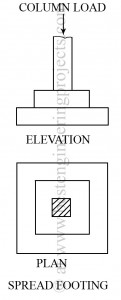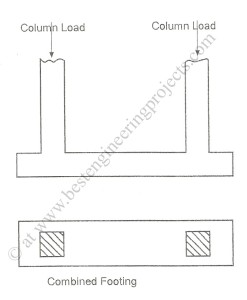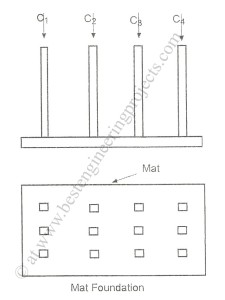What are the types of foundation?
On the basis of load transmission to the ground, there are two types of foundation and they are:
- Shallow foundations and
- Deep foundations.
As we know foundation connects/interfaces two different materials, their strength ratios are of the order of several hundreds. As a result, the load may be spread to the soil in a manner such that its limiting strength is not exceeded and the resulting deflections are tolerable. Description of various types of foundation is given below.
-
SHALLOW FOUNDATION
In shallow foundation, generally, the depth at which the foundation is placed is less than its width i.e. the ratio of depth of foundation to its width is less than unity. This type of foundation spreads the load of superstructure into the ground laterally. Hence shallow foundations are generally known as spread footing. From design point of view, shallow foundations are classified as follows:
- Wall footing
- Isolated column footing or pad footing
- Combined footing
- Cantilever or strap footing
- Mat foundation
The various types of shallow foundations are shown in the figure.
- Wall footing – In order to spread the load carried by the wall into the soil, a wall footing is provided. The foundation is continuous along the direction of the wall. In such a foundation depth to width ratio is 1:2 or 1:3 i.e. the base width is generally two or three times more than the width of the wall at ground level.
Different materials like stones, bricks and sometimes plain or reinforced concrete are used to construct the wall footing. This type of foundations are mostly preferred when the load to be supported are small. In case of dense sands and gravels, wall footings are most suitable and economical at the same time.
- Column footing – In case of column footing, the base of column is enlarged. It may be constructed either from plain or from reinforced concrete. A column footing is also called isolated column footing or pad foundation. The footing may be in different forms: large flat slab, stepped or sloping from column face towards the edge.
Column footing is suitable for the foundations with depth greater than 1.5 m.
Combined footing – In cases of multiple columns in footing, it is used. When a footing is to be made common for two or more columns in a row, it is called combined footing. This type of footing is normally used along the walls of the buildings at property lines where the footing for the column cannot extend outside the limit of structure. Similarly, when columns are closely spaced or the supporting soil is of low bearing capacity and the footings are to be combined, this footing is used. It can be either trapezoidal or rectangular in shape.
Cantilever or strap footing: – Under certain conditions when we have to compromise and it is not possible to further extend an edge footing beyond the boundary of a site due to the presence of an adjoining property, strap footing is used.
In strap footing, the edge column footing is combined with interior column footing by means of a strap beam. Such footings are known as strap footings.
- Mat foundation – when a common foundation is provided for columns in two or more rows, the footing is called a mat or raft foundation. In case of low bearing capacity of the soil and when the foundation requires quite large area for load distribution, mat foundation is provided. Mat foundation is considered more economical than other foundations if the total area of isolated footing needed for a foundation covers more than 50 % area of the building.
Mat foundation is most suited in clayey soil as the whole area under the foundation contributes to the load distribution and this is more effective. Sometimes a mat foundation is used as a floating foundation in a deposit of very soft clay for controlling total as well as differentia settlement.
 DEEP FOUNDATION
DEEP FOUNDATION
In deep foundation, the depth at which foundation is placed is greater than its width. The depth to width ratio of the foundation is usually greater than 4 to 5. Unlike shallow foundations, deep foundations distribute the load of superstructure into the ground vertically rather than laterally.
Few examples of deep foundations are:- Pile foundations, pier foundations and wells or caissons foundations.
When the expected loads from superstructure cannot be supported on shallow foundations, deep foundations are provided.
 Combined footing – In cases of multiple columns in footing, it is used. When a footing is to be made common for two or more columns in a row, it is called combined footing. This type of footing is normally used along the walls of the buildings at property lines where the footing for the column cannot extend outside the limit of structure. Similarly, when columns are closely spaced or the supporting soil is of low bearing capacity and the footings are to be combined, this footing is used. It can be either trapezoidal or rectangular in shape.
Combined footing – In cases of multiple columns in footing, it is used. When a footing is to be made common for two or more columns in a row, it is called combined footing. This type of footing is normally used along the walls of the buildings at property lines where the footing for the column cannot extend outside the limit of structure. Similarly, when columns are closely spaced or the supporting soil is of low bearing capacity and the footings are to be combined, this footing is used. It can be either trapezoidal or rectangular in shape.

 DEEP FOUNDATION
DEEP FOUNDATION
thanks for good image.that is helpful for prepare presentation.